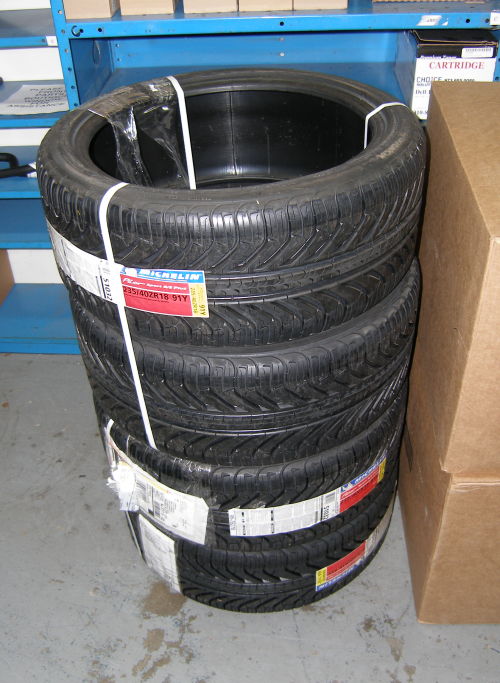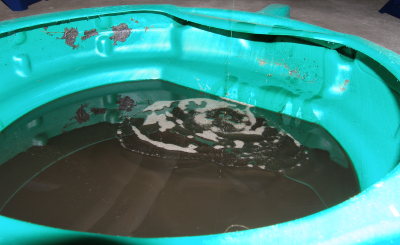Saturday, April 18, 2009
New Summer Shoes
Last year I managed to run my Pilot Sport A/S “summer” tires down to the wear bars so I knew I'd need a new set when it came time to swap out my winter set this spring. I wrestled with the decision to choose a new summer tire and briefly considered the maximum performance summer-only Pilot Sport PS2 but ultimately decided to go with another set of Pilot Sport A/S so this set could serve double duty on the E46 during the winter months. The fact that the Pilot Sport PS2 were $270 in the required fitment only served to reinforce the logic to stick with the A/S. The PS2 is a great tire and from what I've heard is well worth the money but there are more reasonable solutions for a daily driver that spends most of its time munching miles at high speed vs. carving corners at 0.8G.
 The only snag came when Tire Rack's site indicated that the original Pilot
Sport A/S were no longer available because they had been updated to the “A/S
Plus”. I had hoped to buy three tires and put the existing spare on the
right rear to reduce the cost of this set but Tire Rack noted Michelin allowed
mixing of the A/S and A/S Plus only if the A/S Plus were installed on the rear
of the vehicle. This restriction, coupled with the relatively high road force
number of the spare (meaning I couldn't put it on the front without possibly
feeling it in the steering) forced me to leave the spare in its current role
and buy four new A/S Plus.
The only snag came when Tire Rack's site indicated that the original Pilot
Sport A/S were no longer available because they had been updated to the “A/S
Plus”. I had hoped to buy three tires and put the existing spare on the
right rear to reduce the cost of this set but Tire Rack noted Michelin allowed
mixing of the A/S and A/S Plus only if the A/S Plus were installed on the rear
of the vehicle. This restriction, coupled with the relatively high road force
number of the spare (meaning I couldn't put it on the front without possibly
feeling it in the steering) forced me to leave the spare in its current role
and buy four new A/S Plus.
Always accommodating, my dealer's parts department allowed me to drop ship the tires to them. I then arranged to bring the wheels to my technician loose (off the car) so he could get to them as his schedule permitted. I asked him to write the road force balancing numbers on the tires so I would be able to report them here as well as figure out where to best mount each tire and he agreed to do so.
The next evening I went to pick up the tires after work and took note of the numbers as I hauled each wheel into my brother's pickup truck: 3, 8, 15, and something that resembled either “21” or “12” with a backward “2”. I couldn't ask my technician to clarify it because he had left for the day so I figured I'd return the next day...particularly because I had to question the bill anyway.
Long time readers may note that I worked a deal with the service manager to mount and balance tires brought to them “loose” for $40 each. This is largely because I save the techs the labor to R&R the wheels on the car and save the shop from having to tie up a valuable service bay or provide a loaner car. I couldn't confirm the price with the service manager at the time I dropped off the wheels because he was stuck in a meeting so you might imagine my surprise when I was presented with the invoice and noticed I was charged $50 (!) per tire.
The service advisor told me that non-runflat tires were typically billed 0.5 hours ($60) and runflat 0.7 ($84) while 18” or larger non-runflat were billed 0.6 ($72) because they're almost as challenging as run-flat tires to mount. The increase in price reflected their recent increase in labor rate to $120 per hour. While I was still somewhat miffed that I had to pay more this time around, I didn't feel as bad when my technician separately revealed that they had to do some extra work to get the tires to balance properly.
A discussion with my technician revealed that the “21” was in fact “12”, so all tires balanced out below the BMW spec of 18 pounds. Interestingly, the tire that balanced with a mere 3 pounds first balanced at 30 pounds. They dismounted the tire, flipped it 180 degrees and it balanced almost perfectly. He also told me that the tire that balanced at 15 pounds originally balanced at 25 pounds. As he spun it up he noticed an eccentricity typical of the effects of an overly tight shipping strap and possibly the consequence of being at the bottom of a stack of tires. The solution was to mount the tire, over-inflate it to 55 PSI, leave it overnight at that pressure, and then take it through the balancing procedure again the next day. The result? The highest road force number of the lot, but still under BMW specs.
My technician summarized by saying road force balancing allows them to match the tire to the wheel in a way that traditional dynamic balancing cannot accomplish. So if I needed another reason to insist on and perhaps pay a bit more for road force balancing, this was it. If I ever open an indy shop or run into enough money that I can equip my own garage with the best equipment I'll be calling Hunter, that's for sure.
One great thing to come out of this balancing session is that the required weights were installed on the inner surface of the wheels just inside of the “spokes”. My technician indicated that this was due to a recent update to the balancing machine, but no matter...the perk for me is that the weights are not as easily visible from the outside. Some residual glue remained from the old weights but I managed to clean that off with some kerosene before I mounted the tires for the summer driving season.
As for the winter set, the rear tires are essentially at the snow traction wear bars (which are themselves almost 2mm above the standard traction wear bars) while the front tires are a good 1-2mm above the snow traction wear bars. While the fronts could probably serve another season, when I compare the tread with that of the still-new spare, it's no contest. I plan to replace the entire set as planned and may do it earlier in the year than usual to take advantage of off-season pricing, which currently stands at $30 per tire lower than I paid for the last set.
Four Pilot Sport A/S in 235/40/18 fitment cost $825 + $40 for shipping or $865 total. Mounting and balancing of the new tires and trashing the old tires cost $216. I did manage to save $92 in labor by negotiating with the service manager and installing the wheels myself. While this isn't exactly a great deal, in this economy I'll take all the discounts I can get.
Differential Oil Change
 While the gear oil in an open-differential doesn't take near the abuse of
one equipped with a limited slip unit it's still important to change oil
on an open differential at some regular interval. Of course, you'd never know
this by listening to BMWs latest maintenance schedule, which
insists that on all vehicles but the M cars (effectively all open differentials)
the gear oil is a “lifetime
fill”.
Ask any differential rebuilder for the truth on the matter and you'll hear
otherwise I can assure you. For this reason my maintenance schedule now includes
a differential gear oil change every 36K miles, or every Inspection II.
While the gear oil in an open-differential doesn't take near the abuse of
one equipped with a limited slip unit it's still important to change oil
on an open differential at some regular interval. Of course, you'd never know
this by listening to BMWs latest maintenance schedule, which
insists that on all vehicles but the M cars (effectively all open differentials)
the gear oil is a “lifetime
fill”.
Ask any differential rebuilder for the truth on the matter and you'll hear
otherwise I can assure you. For this reason my maintenance schedule now includes
a differential gear oil change every 36K miles, or every Inspection II.
The first differential oil change I performed after 125K miles revealed a relatively thin translucent brown fluid full of fine metallic particles that shimmered in the sunlight – a stark contrast to the transparent very light amber color of the new Mobil 1 75W-90 synthetic gear oil I used at the time. Roughly 40K miles later I managed to do my second DIY differential oil change. Given the relatively few miles on the oil as compared to the original fill I expected to find the oil in relatively good shape. However, what came out was a dark brown, opaque oil similar to used engine oil.
Not having much experience with differential oil it's hard to say whether this is normal or not but I can say with some confidence that it was in worse condition than the original fill. Whether that's a reflection of the oil itself being inferior to the OE fluid (unlikely) or the fact that something inside the differential is wearing at an accelerated rate (more likely) I don't know yet. In the interest of keeping an eye on things I plan to halve my differential oil change interval to 18K miles until I see an improvement in the condition of the oil or something fails and I wind up overhauling the differential -- whichever comes first.
Two quarts of Mobil 1 75W-90 gear oil cost $20. Book labor for a differential flush is 0.8 hours so I managed to save another $96 doing this myself.
Rear Drivetrain Noise
While I had the rear of the car jacked up I rotated the wheels to make sure all was well. As I rotated the right rear wheel clockwise (the same direction as forward travel of the car) I heard a strange noise similar to that I imagine would occur if sand were placed between two meshing metal surfaces. It was very faint, but seemed to come from the general vicinity of the right rear wheel. Initially I thought the wheel bearing might be on its way out but when I rotated the wheel in the opposite direction the noise moved to the left side of the car. When I rotated the left wheel the same thing happened.
I wish I could say I knew what is causing this but I have no clue. It may be related to the state of the differential fluid but appearances can be deceiving. All I can say is that this is something new and it's not normal. In fact, I think it represents another vote in favor of rebuilding the rear but I'll reserve that judgment until I have more information.
Mileage: 175300, Parts: $885, Labor: $216, Labor Saved: $188



